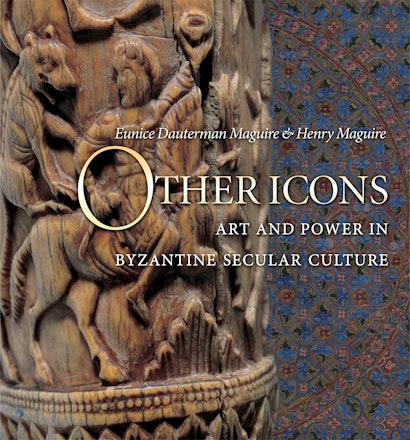A winged centaur with the spotted body of a leopard playing a lute; a naked man with an animal head; a goat-footed Pan; a four-bodied lion; sphinxes and hippocamps. Few would associate these forms of art with the Byzantine era, a period dominated by religious art. However, art of strikingly secular expression was not only common to Byzantine culture but key to defining it. In Other Icons, Eunice Dauterman Maguire and Henry Maguire offer the first comprehensive view of this unofficial Byzantine art, demonstrating the role it played in dialogue with traditional Christian Byzantine art.
With wide-ranging examples, this beautifully illustrated book vividly demonstrates how the surprise of this profane art is not only in its subjects of mythic creatures, exotic imagery, and eroticism but also in the ubiquity and beauty of their placement—within churches and without, woven into silk, illuminated on manuscripts, engraved into pottery, painted in frescoes, and taking life in marble, bone, and ivory.
Presenting and exploring this profane art, Other Icons offers a surprising new way of seeing Byzantine art.
Awards and Recognition
- Honorable Mention for the 2006 Award for Best Professional/Scholarly Book in Arts and Art History, Association of American Publishers
Eunice Dauterman Maguire is former curator of the Archaeological Collection and senior lecturer in art history at Johns Hopkins University. She is the author of Weavings from Roman, Byzantine, and Islamic Egypt and (with Henry Maguire and Maggie J. Duncan-Flowers) Art and Holy Powers in the Early Christian House. Henry Maguire is professor emeritus of art history at Johns Hopkins University. He is the author of Art and Eloquence in Byzantium and The Icons of Their Bodies: Saints and Their Images in Byzantium (both Princeton).
"This is an extremely important book, one that makes a highly original and much needed contribution to a fascinating field that is ripe for new work. It is written in a lively, accessible style that will captivate the general as well the specialist reader. The text could even serve effectively in advanced introductory courses on medieval art. Most significantly, it opens the topic of Byzantine secular art to further inquiry. . . . Other Icons is exciting and provocative, both for the innovative and persuasive interpretations it offers on secular art in Byzantium and for the intriguing issues it illuminates for further study."—Alicia Walker, Art Bulletin
"Eunice and Henry Maguire have produced an engaging book that will serve for years to come as a welcome starting point for students and scholars interested in the secular arts of Byzantium. . . . The book's ample illustrations and lively prose make its recondite implications comprehensible to a wide range of readers. . . . At once lucid and crisply argued, this book offers an innovative and important discussion of secular Byzantine art."—Anne McClanan, Speculum: A Journal of Medieval Studies
"This is a well-written and richly illustrated book with good quality black and white and color photographs, enjoyable to read, and impressive for the diversity of the topics raised and for the wide range of the artistic works discussed. . . . Other Icons is a thought-provoking and groundbreaking study and though some of the new interpretations proposed might appear controversial . . . they remain important for advancing the discussion on the nature and reception of profane art in medieval Byzantium, even by sparking opposition."—Maria G. Parani, Studies in Iconography
"The treatment of the selected objects in this well presented and illustrated book leads to a new conclusion on a traditional problem of Byzantine art, the question of how far and in what ways its Medieval art connects with ancient Graeco-Roman art."—Robin Cormack, Journal of Hellenic Studies
"The new corpus of material assembled here will surely spur further investigation into how all the Byzantine arts, broadly defined, served to reflect, reinforce, and construct a Byzantine worldview. Merely by gathering together so much 'unofficial' art, the Maguires have done a huge service. Even more impressive is their successful attempt to make sense of this disparate body of material by interpreting it consistently, yet flexibly, in relation to the familiar 'official' arts. Byzantine art history, and especially the teaching of Byzantine art history, will never be the same."—Linda Safran, University of Toronto
"Impeccably referenced and beautifully illustrated, Other Icons opens up a new side of Byzantine art at the height of its creativity."—Carolyn Connor, University of North Carolina, Chapel Hill

